A separation letter is a formal document given to employees when they leave their jobs. It explains the reasons for leaving and delivers important facts about their departure.
What is a Separation Letter?
A separation letter is a written notice that an employee’s job has ended. It can be used in different conditions, such as layoffs, resignations, or mutual agreements to part methods. This letter supports both the employer and the employee in comprehending why the separation is occurring and what the terms are.
Why a Separation Letter is Important
It is very important for both the employer and the employee. Here’s why:
Legal Proof
It is a legal proof that an employee has left the company. This document is helpful for any disputes or questions about why the employee left. It protects both the employer and the employee from misunderstandings.
Record Keeping
Keeping accurate records is essential for any business. It helps maintain clear records of when and why an employee left the company.
Clarity for the Employee
The separation letter informs the employee about their termination. It includes details like the last working day, the reason for leaving, and any next steps.
Transparency
Providing a separation letter shows transparency from the employer.
Avoiding Misunderstandings
Having everything in writing helps avoid misunderstandings. The letter clearly states the facts, which can prevent any confusion about the terms of separation.
Essential Elements of a Separation Letter
It should include some key parts. Here’s what to include:
Employee Details
Start with the employee’s full name and job title. This helps identify who the letter is about.
Termination Date
Clearly state the last day the employee will work. This gives a clear timeline for the end of employment.
Reason for Separation
Explain why the employee is leaving. Be clear and honest. This helps avoid misunderstandings. Reasons can include:
- Resignation
- Layoff
- Mutual agreement
- Performance issues
- Company restructuring
Return of Company Property
If the employee has any company items, mention when and how they should return them. This can include:
- Keys
- ID badges
- Laptops
- Any other company property
Final Pay Details
Include information about the final paycheck. State when and how the employee will receive it. Mention any unused vacation days or other benefits for which they will be paid.
Benefits Information
Provide details about what happens to the employee’s benefits. This can include health insurance, retirement plans, and other benefits. Explain if and how they can continue or convert these benefits.
Contact Information
Give the employee a contact number or email where they can ask questions. This will help them easily get the information they need.
Including these elements ensures that the letter is complete and clear. This helps both the employer and the employee understand the terms of the separation. It makes the process smooth and professional, reducing confusion and misunderstandings.
How to Write a Separation Letter
Writing a separation letter can be straightforward if you follow a step-by-step guide:
- Start with a Greeting
Start with a formal greeting and state the letter’s purpose. For example:
- “Dear [Employee’s Name],”
- State the Purpose
Explain right away that the letter is about ending their employment. Be clear and direct. For example:
- “This letter is to inform you that your employment with [Company Name] will end on [Last Working Day].”
- Include Employee Details
Mention the employee’s job title and department. This identifies who the letter is for. For example:
- “You have been a valued member of the [Department Name] as a [Job Title].”
- Give the Termination Date
Clearly state the last day the employee will work. This provides a clear timeline. For example:
- “Your last working day will be [Date].”
- Explain the Reason
Briefly explain why the employment is ending. Be honest but respectful. For example:
- “The reason for your separation is [reason, such as company restructuring or performance issues].”
- Provide Next Steps
Tell the employees what they need to do next. This might include returning to company property or attending an exit interview. For example:
- “Please return all company property, including your ID badge and laptop, by [date].”
- Mention Final Pay
Explain when and how they will receive their last paycheck. Include details about any unused vacation days or benefits. For example:
- “You will receive your final paycheck on [Date]. This will include payment for any unused vacation days.”
- Offer Assistance
Provide contact information for any questions they might have. This helps them get more information if needed. For example:
- “If you have any questions, please contact [HR Contact Name] at [Phone Number] or [Email Address].”
- Close Politely
End the letter on a positive note. Thank the employee for their work and wish them well. For example:
- “Thank you for your contributions to [Company Name]. We wish you all the best in your future endeavours.”
- Sign the Letter
Include a signature from an authorised person, like a manager or HR representative. This makes the letter official. For example:
- “Sincerely, [Your Name] [Your Title]”
Future Employment Implications
It can affect an employee’s future job prospects. Here’s how:
Impact on Job Applications
Potential employers might ask for details about past jobs when applying for new jobs. It can provide a clear reason for leaving the previous job, helping future employers understand the situation better.
Reference Checks
Future employers may contact previous employers to verify employment details. A well-written letter can provide accurate information, making reference checks smoother. It ensures that the reasons for leaving are clear and factual.
Addressing Employment Gaps
If there is a gap in employment, a separation letter can explain why. This is important because it helps future employers understand what happened during that time. It can make the employee’s job history more transparent.
Avoiding Misunderstandings
It can ensure understanding. It clearly states the reason for leaving, which helps avoid confusion or negative assumptions from future employers.
Separation Letter vs. Termination Letter
While both letters deal with ending employment, they are not the same. Here’s the difference:
Separation Letter
A separation letter is a general document that can be used for various employment endings. This includes voluntary resignations, layoffs, or mutual agreements to part ways. It covers a broad range of scenarios where an employee leaves the company.
Termination Letter
A termination letter is specific to situations where the employer terminates the employee’s employment. This is usually due to performance issues, misconduct, or company policies. The letter clearly states that the termination was not the employee’s choice.
When to Use Each Letter
- Separation Letter: Use this when an employee leaves voluntarily, is laid off, or when there is a mutual agreement to end the employment.
- Termination Letter: This is used when the employer terminates employment for specific reasons, such as poor performance or violating company rules.
Clarity and Transparency
Both letters should be clear and professional. They provide important information about the end of employment and help avoid misunderstandings.
Signing the Separation Letter
Signing a separation letter is an important step. Here’s why and how it should be done:
Who Should Sign the Letter?
Someone with authority in the company should sign the letter. This could be a manager, a human resources (HR) representative, or a company executive. The signature shows that the document is official and approved by the company.
Why is the Signature Important?
The signature adds authenticity to the letter. It shows that the information in the letter is correct and has been reviewed by the company, making the letter more credible and trustworthy.
Where to Sign?
The signature should be placed at the bottom of the letter. It should include the name and title of the person signing the letter. This helps to identify who has authorised the letter.
Delivering the Separation Letter
Delivering the letter properly is crucial. Here are some steps to ensure it is done right:
Methods of Delivery
- In-Person: Handing the letter to the employee in person is a direct and respectful way to deliver it. This allows for immediate discussion and questions.
- Email: Sending the letter via email is quick and ensures there is a digital copy. Request a read receipt to confirm that the employee has received it.
- Certified Mail: Using certified mail provides proof of delivery. This is useful if there are legal requirements or if you must ensure the letter has been received.
Ensuring Receipt and Acknowledgment
It’s important to make sure the employee receives and acknowledges the letter. Here are some tips:
- Follow-up: Follow up with the employee to confirm receipt after sending the letter.
- Acknowledgement: Ask the employee to sign a copy of the letter to confirm they have received and read it. If delivered by email, ask for a confirmation reply.
Respect and Professionalism
Delivering the letter should be done with respect and professionalism. The process should be handled with care, whether in person, by email, or by mail. This helps maintain a positive relationship and ensures that the employee feels respected.
Contesting a Separation Letter
Sometimes, an employee might disagree with the reasons in a separation letter. Here’s what they can do:
Dispute the Letter
Employees who think the letter is unfair can dispute it. This means they can ask the company to review the reasons for their separation. The employee should talk to the Human Resources (HR) department first.
Seek Legal Help
If talking to HR doesn’t work, the employee can seek legal help. A lawyer can advise on the employee’s rights and help the employee understand what steps to take next.
Gather Evidence
The employee should gather any evidence that supports their case. This can include emails, performance reviews, or witness statements. This information can help when discussing the issue with HR or a lawyer.
Stay Calm and Professional
It’s important to stay calm and professional during this process. Even if the situation is upsetting, keeping a cool head will help resolve the issue more effectively.
Legal Requirements for a Separation Letter
Employers must follow certain laws and rules when issuing a letter. Here’s what you need to know:
Follow Employment Laws
Employers must follow local and national employment laws when creating a separation letter. These laws ensure that employees are treated fairly, and the company should be aware of these laws to avoid any legal issues.
Company Policies
Each company may have its own policies about handling separations. These policies can include how to write the letter, who should sign it, and how to deliver it. Following these policies helps ensure the process is consistent and fair for all employees.
Timely Delivery
The letter should be given to the employee promptly. This means the employee should get the letter soon after making the decision. Delaying the letter can confuse and may not comply with legal requirements.
Clear and Complete Information
The letter should provide clear and complete information about the separation. This includes the reasons for the separation, the last working day, and any next steps the employee needs to take. Providing all this information helps the employee understand their situation better.
Proof of Delivery
Employers should have proof that the employee received the letter. This can be done through a signed acknowledgement from the employee, a read receipt from an email, or confirmation from certified mail. Having proof of delivery is important for legal and record-keeping purposes.
Both employers and employees can ensure the separation process is fair, legal, and clear. This helps maintain a good relationship and prevents misunderstandings.
Separation Letter from Employer
A separation letter from an employer is a document given to employees when they leave a job. It explains their leaving, their last workday, and any next steps. This letter is important for legal proof and keeping records.
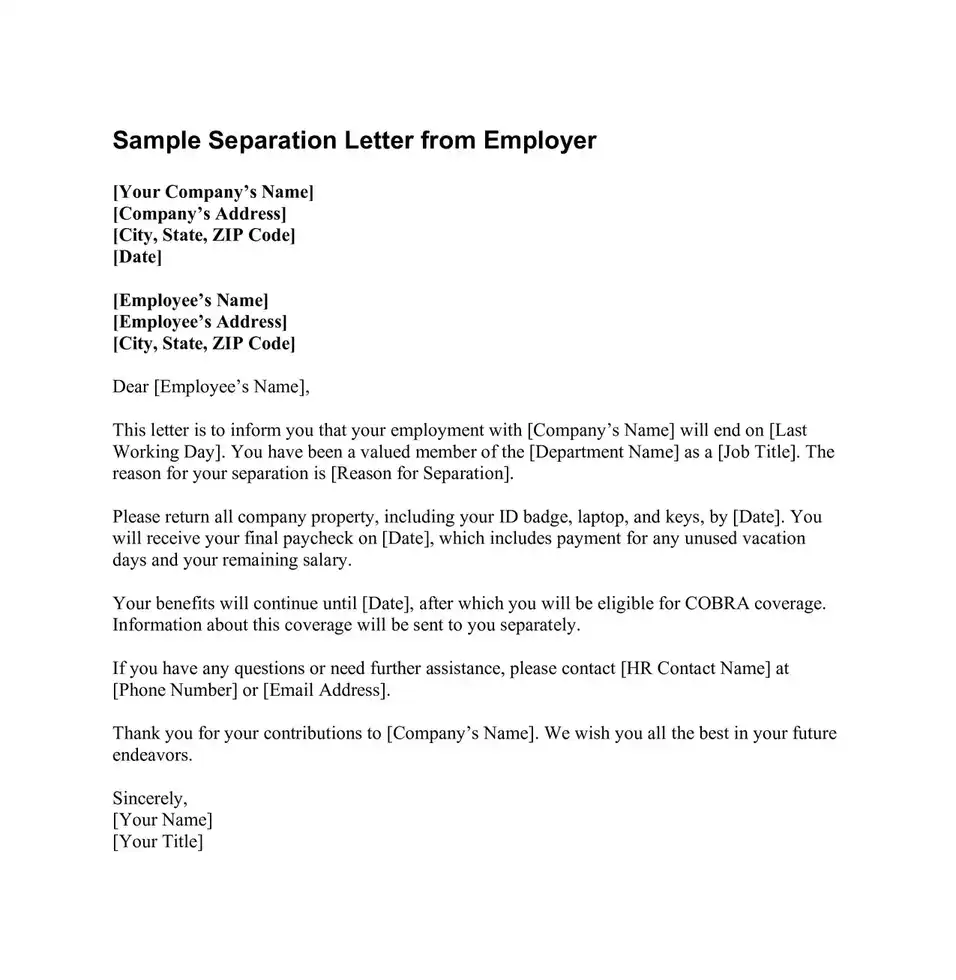
Separation Letter Template
A separation letter template is a ready-made document that helps employers write a separation letter easily. It includes sections for employee details, the last workday, the reason for leaving, and other important information.
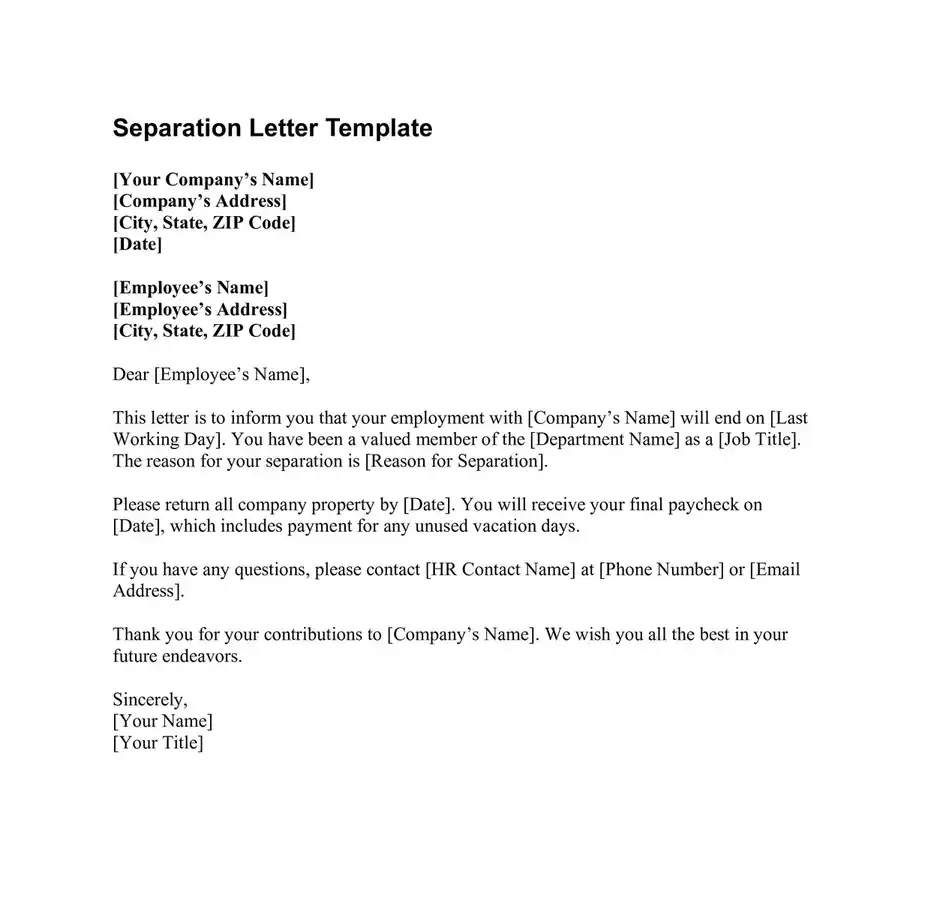
Separation Letter to Husband
It is a personal letter written by a wife to tell her husband she wants to separate. It should be clear, honest, and respectful, explaining why she wants to separate and what happens next.
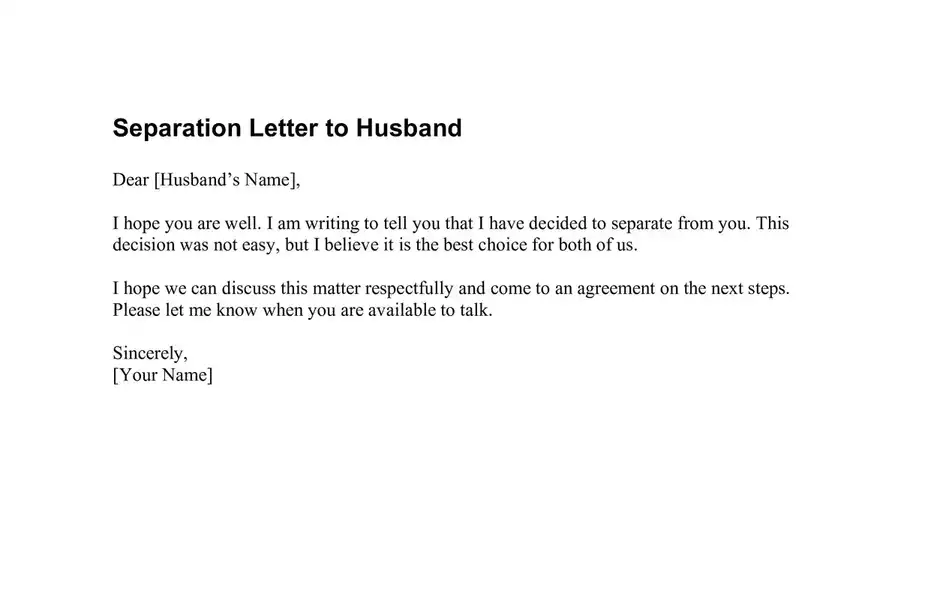
Separation Letter to Wife
A husband writes a letter to a wife to tell his wife he wants to separate. The letter should be kind and honest, explaining why he wants to separate and what steps they need to take next.
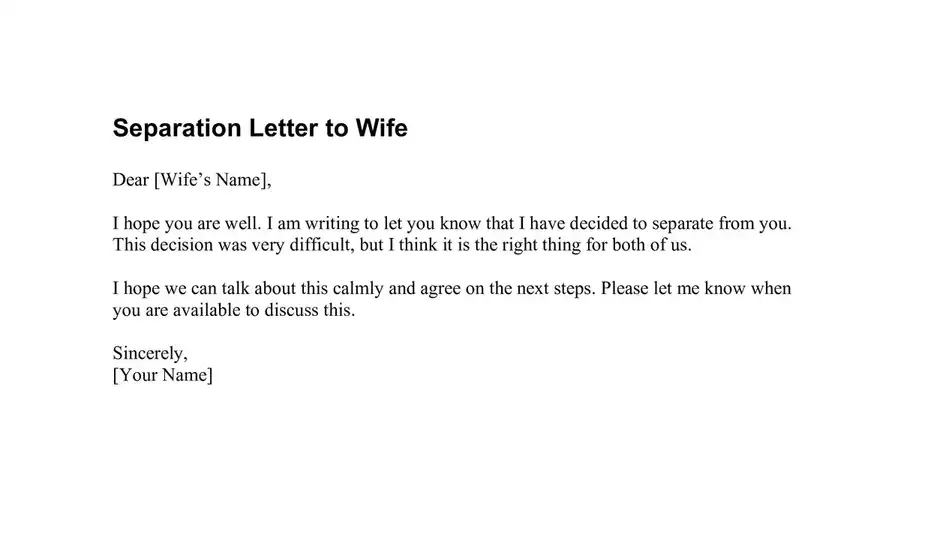
Termination Letter Without Cause
A termination letter without cause is given to an employee when their job ends for no specific reason related to their performance. It usually includes the last workday and information about final pay and benefits.
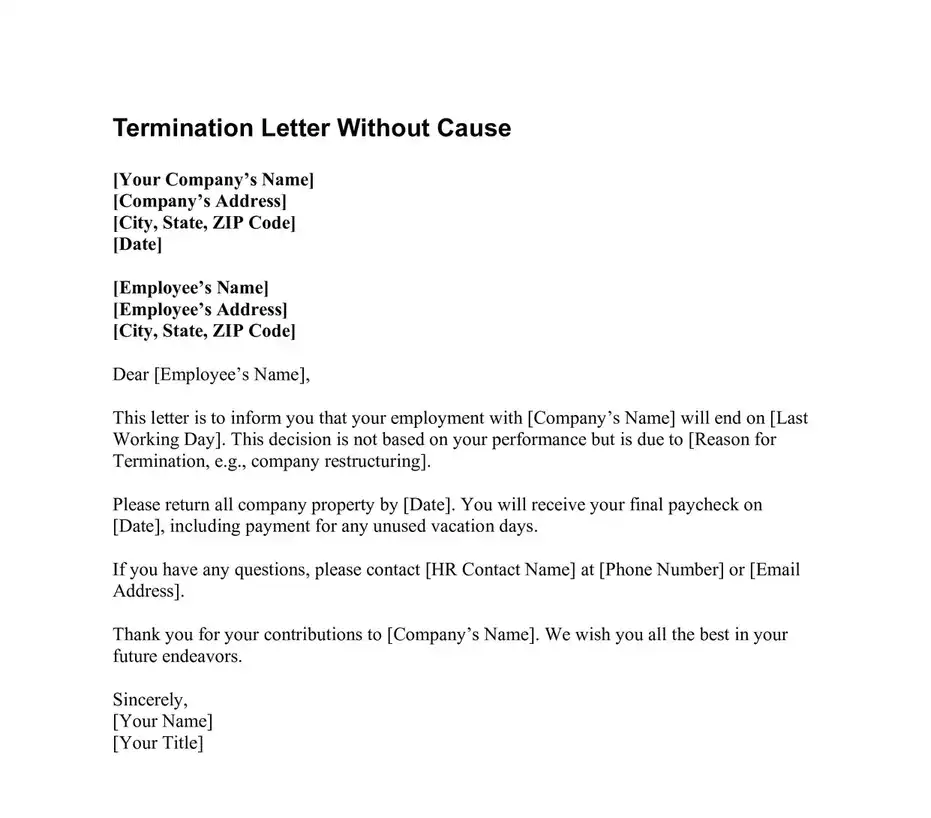
Separation Letter for Marriage
One spouse writes a separation letter for marriage to the other to formally announce their decision to separate. It should include reasons for the separation, any terms of the separation, and what happens next.
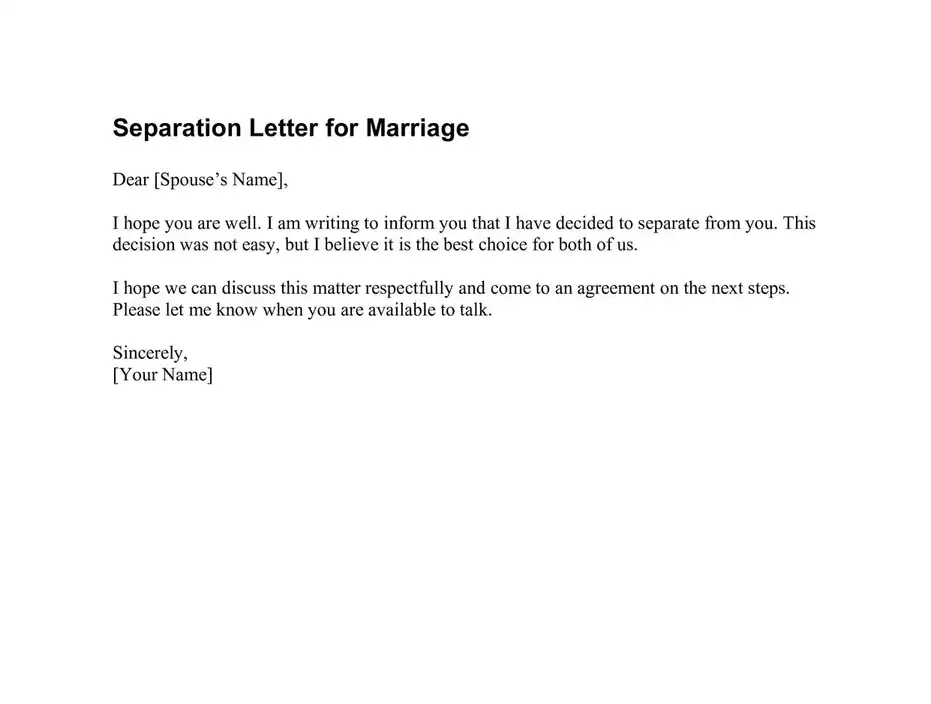
Proof of Separation Letter
A proof of separation letter confirms the separation of two people from a job or marriage. This letter is often needed for legal, financial, or administrative purposes.
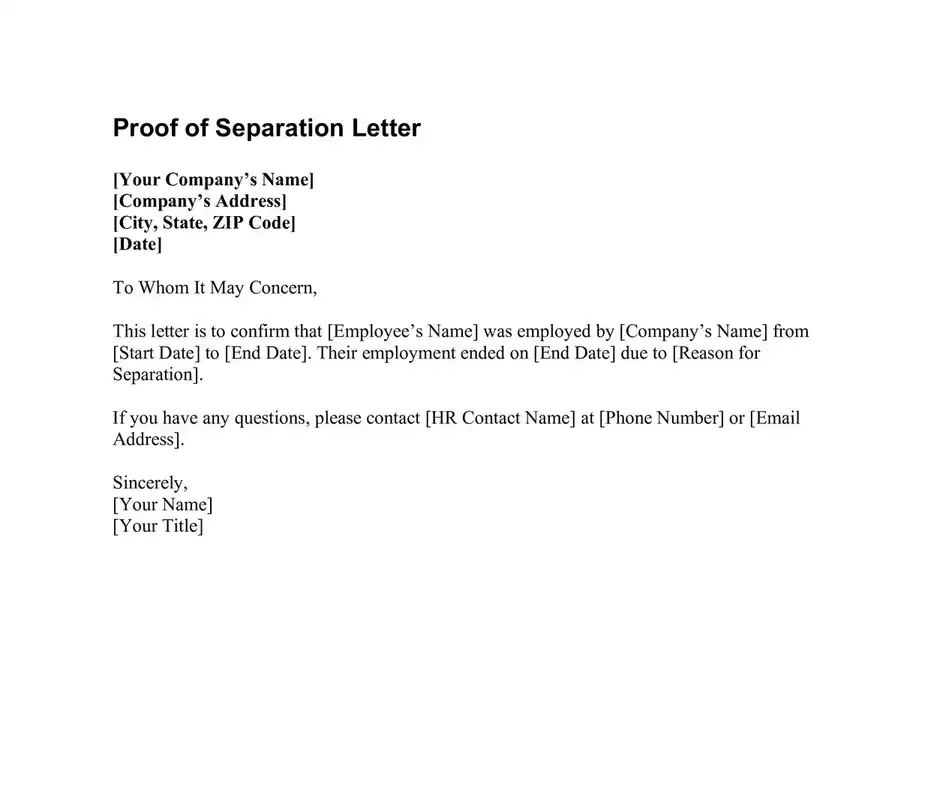
Separation Letter for Centrelink
A separation letter for Centrelink informs Centrelink, the Australian government service, about a change in relationship status. This letter helps update personal records and ensures the correct benefits are provided.
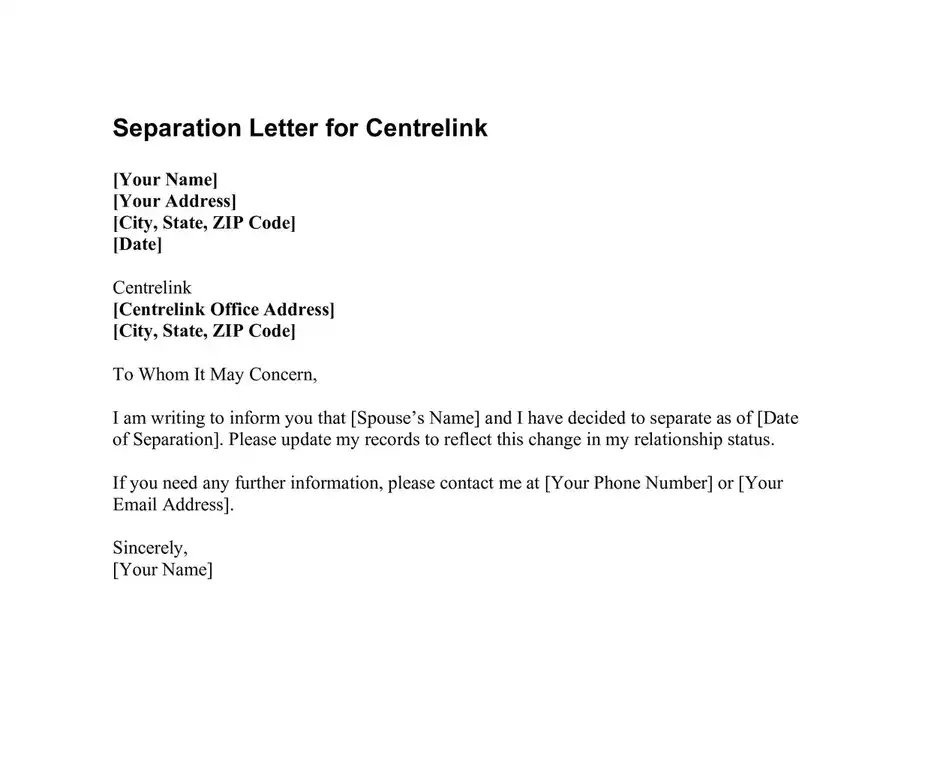
Separation Letter in Georgia
It is follows the state-specific rules for creating a separation document, whether for job or personal reasons. It must follow Georgia state laws and guidelines.
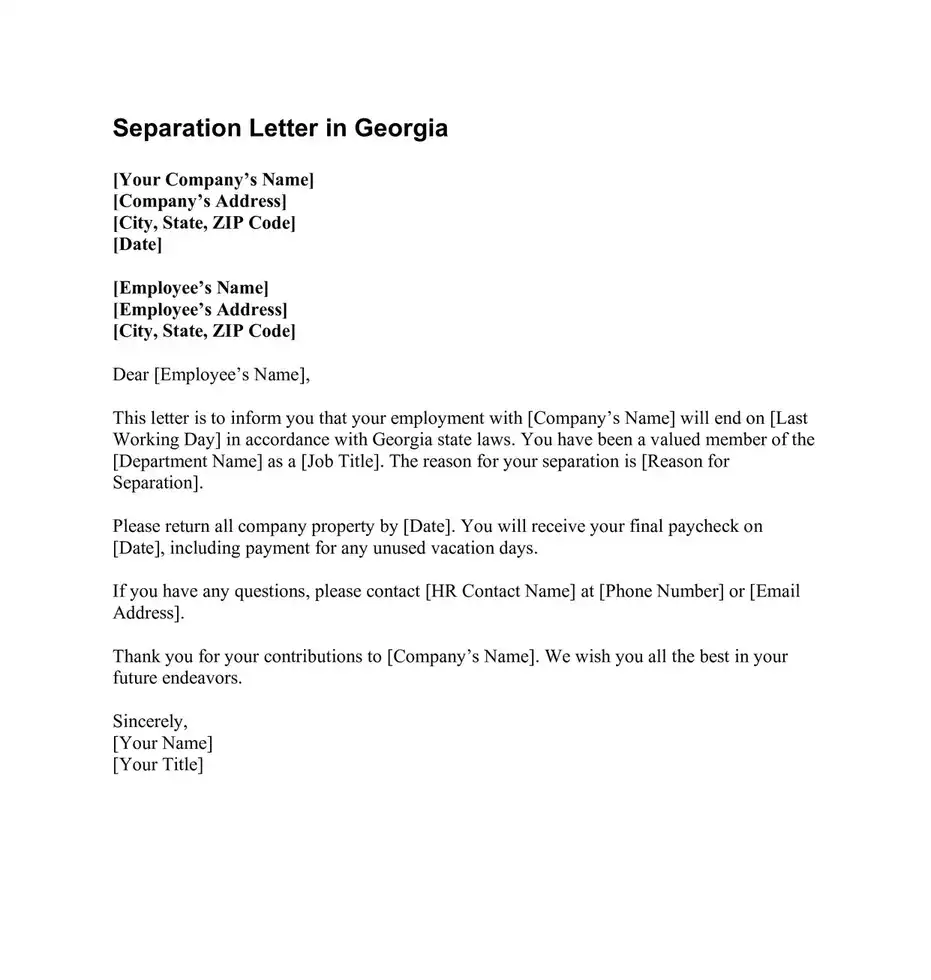
Notice of Separation Letter
It is a formal notification to an employee or spouse about the end of a job or relationship. It details the reasons, the effective date, and any required actions.
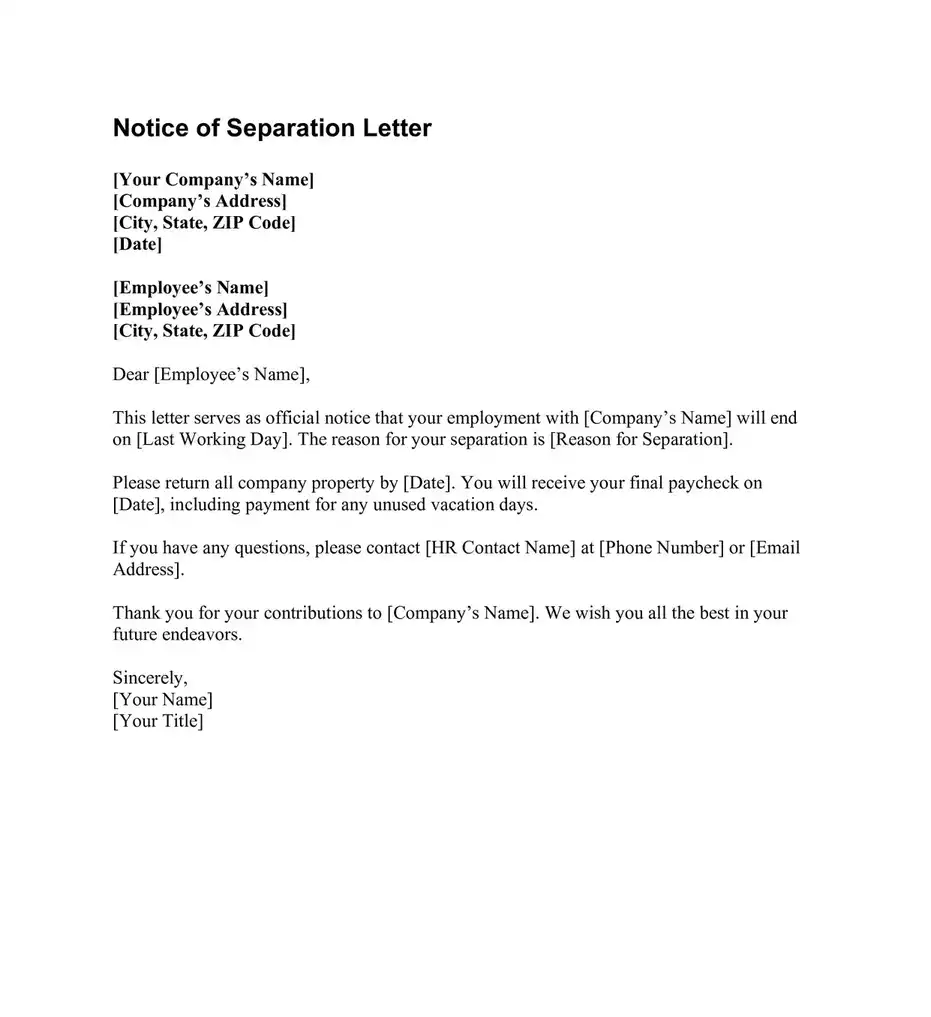
USPS Separation Letter
When employees leave their jobs, the USPS sends them a letter. The letter includes the last workday, reasons for leaving, and information about final pay and benefits.
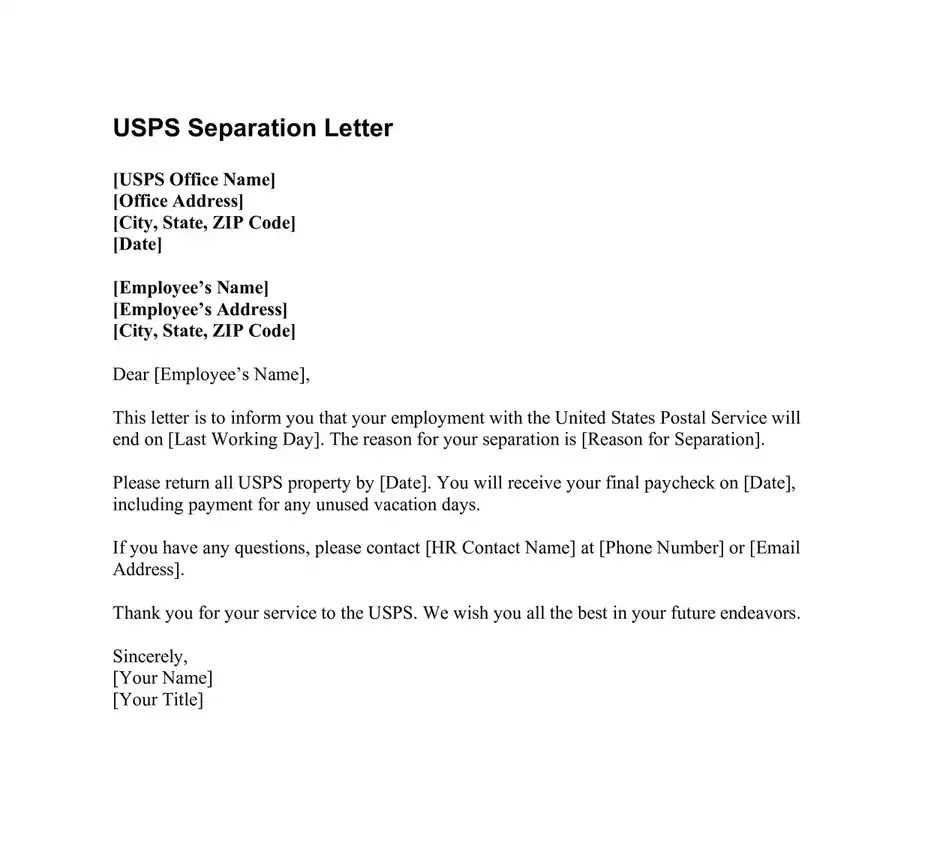
Walmart Separation Letter
When employees leave the company, they receive a letter that outlines their reasons for leaving, the last workday, and any important details about final pay and benefits.
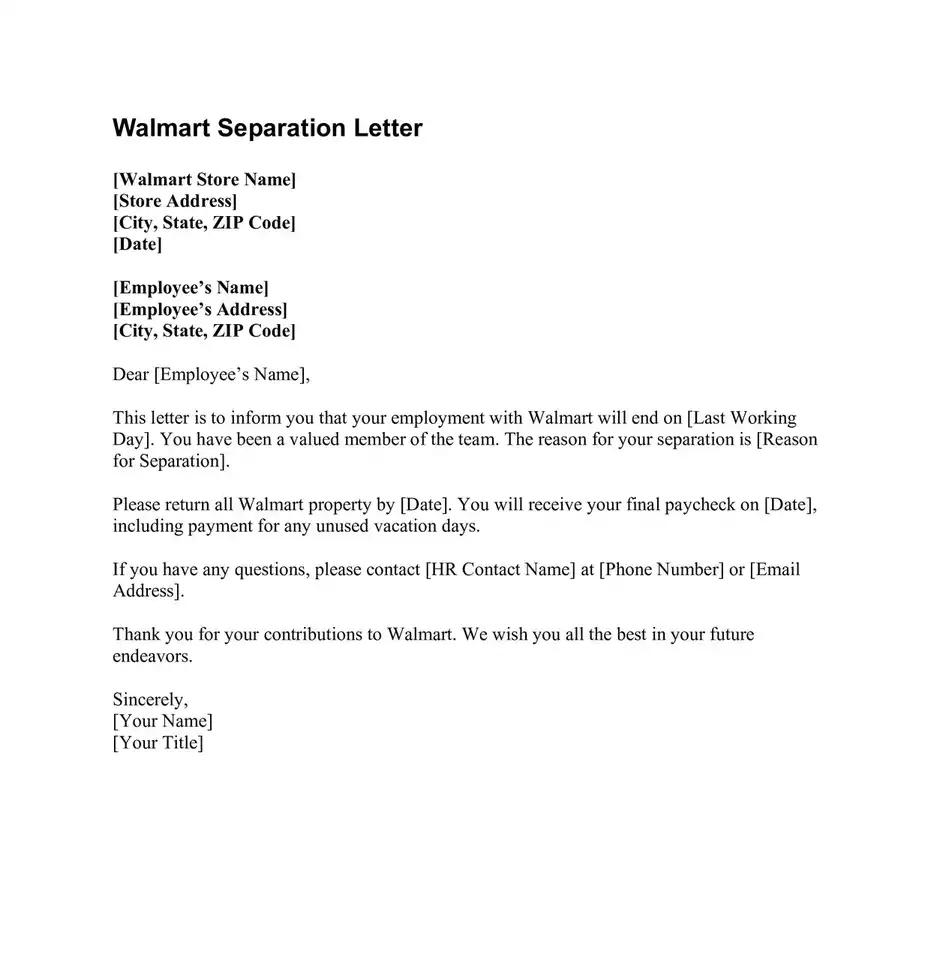
Separation Letter for Personal Reasons
An employee leaving the company for personal reasons receives a letter. It includes the last working day and any next steps, ensuring a smooth transition while respecting the employee’s personal decision.
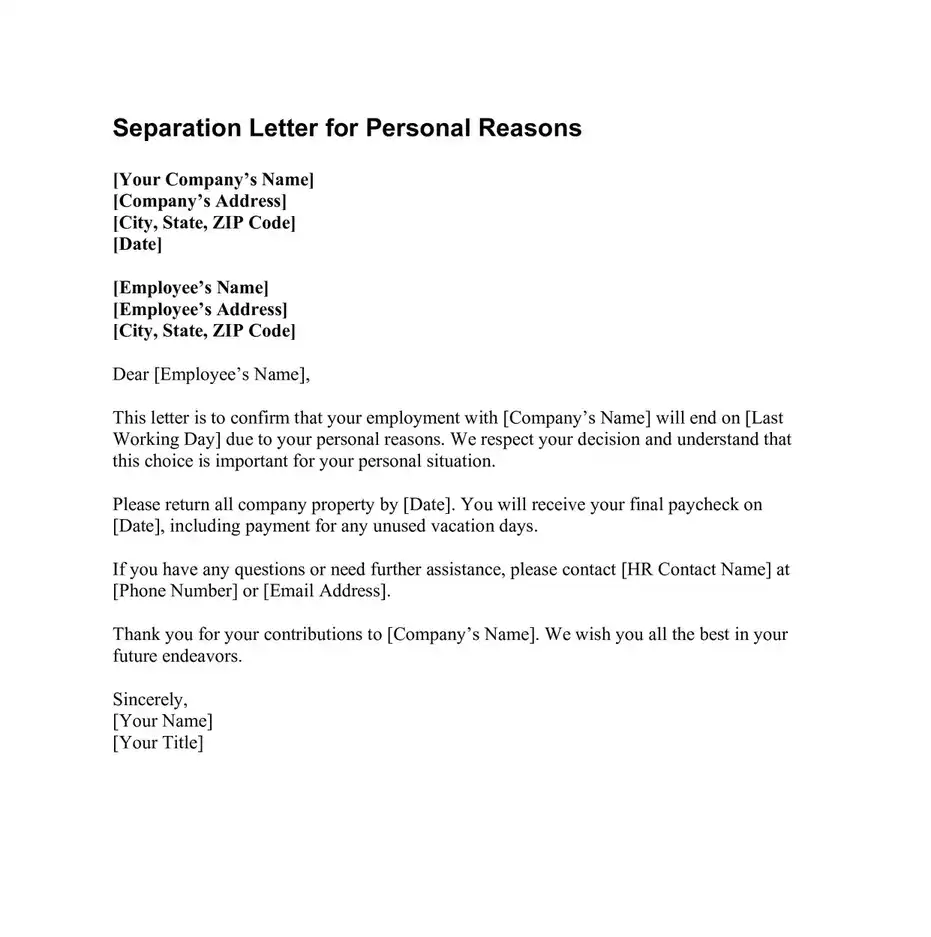
Separation Letter for Medical Reasons
This is a letter confirming the end of employment due to the employee’s medical reasons. It expresses sympathy for their health issues and includes details about the last working day and final pay.
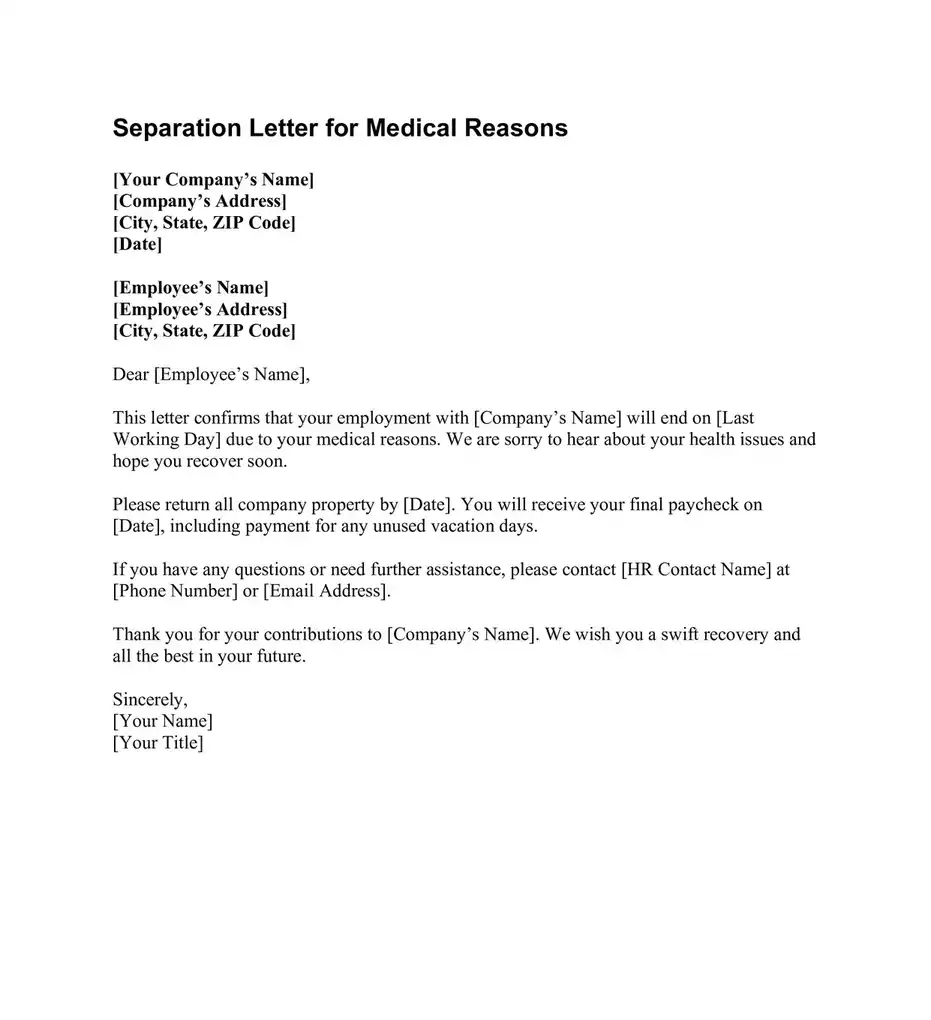
Separation Letter for Poor Performance
This is a letter explaining that the employee’s job ends due to not meeting performance standards. It includes the last working day, feedback previously given, information about returning company property, and final pay.
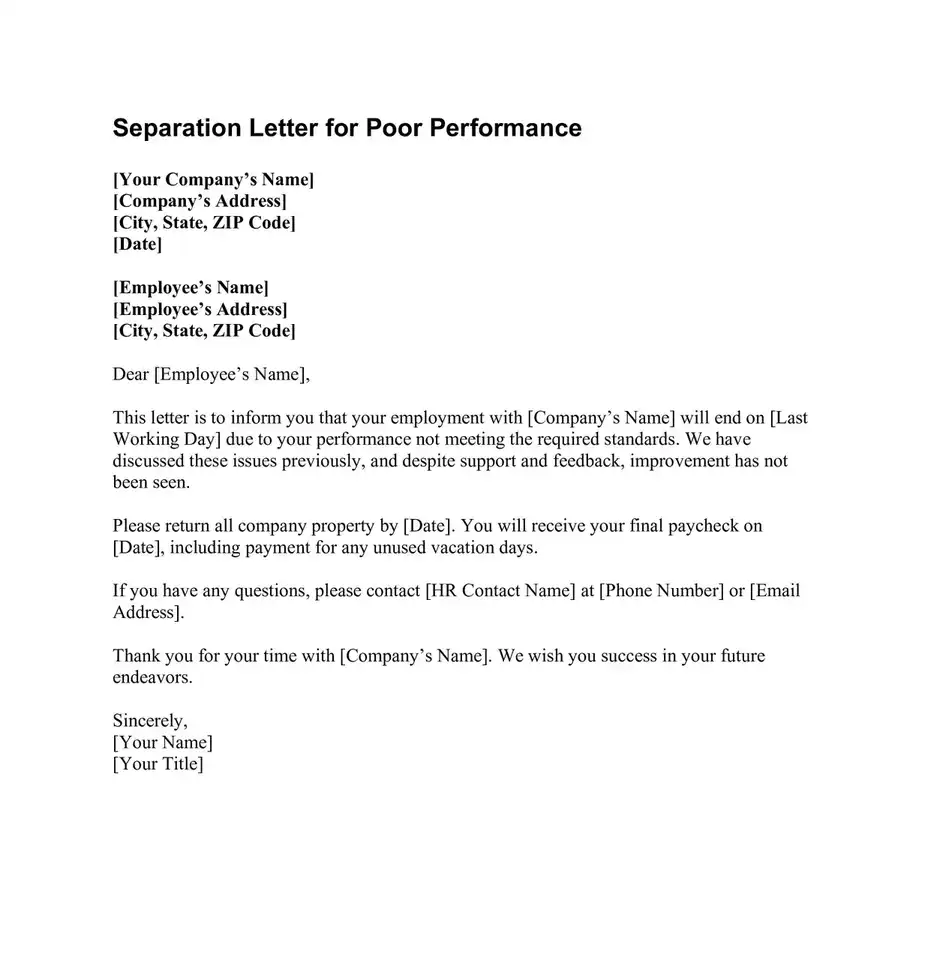
Separation Letter for Retirement
A letter confirming an employee’s retirement and ending of employment. It thanks the employee for their service, includes the last working day, and details about final pay and returning company property.
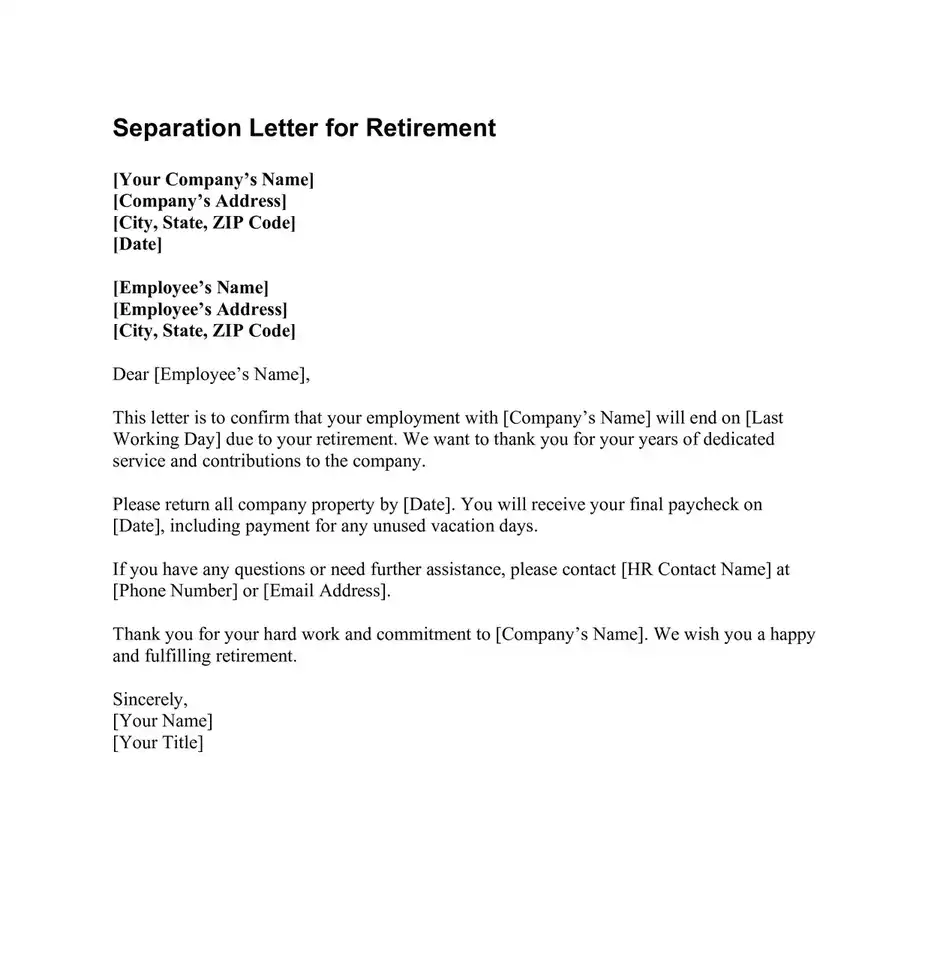
Separation Letter for Mutual Agreement
A letter stating that the employment ends by mutual agreement between the employer and employee. It includes the last working day, reasons for the agreement, and steps to return company property and receive the final paycheck.
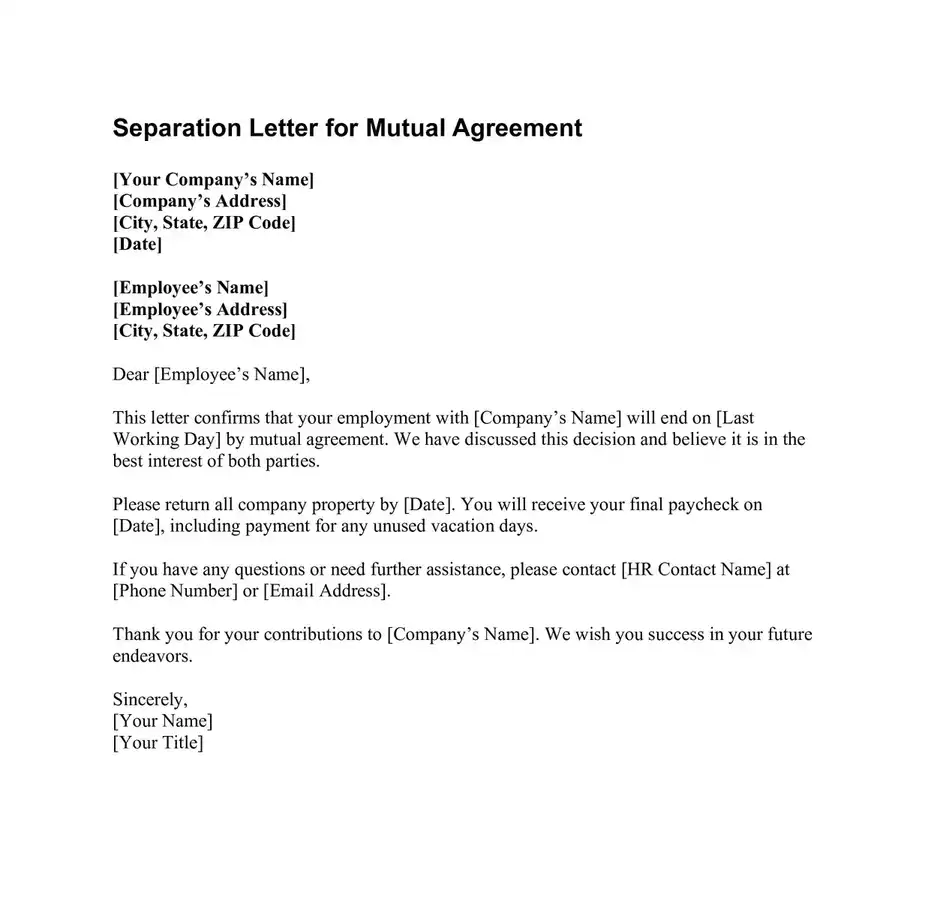
Separation Letter for Layoff
A letter informing an employee that their job is ending due to a company-wide layoff. It explains that the decision is not based on performance, provides the last working day, and includes information about final pay and any severance packages.
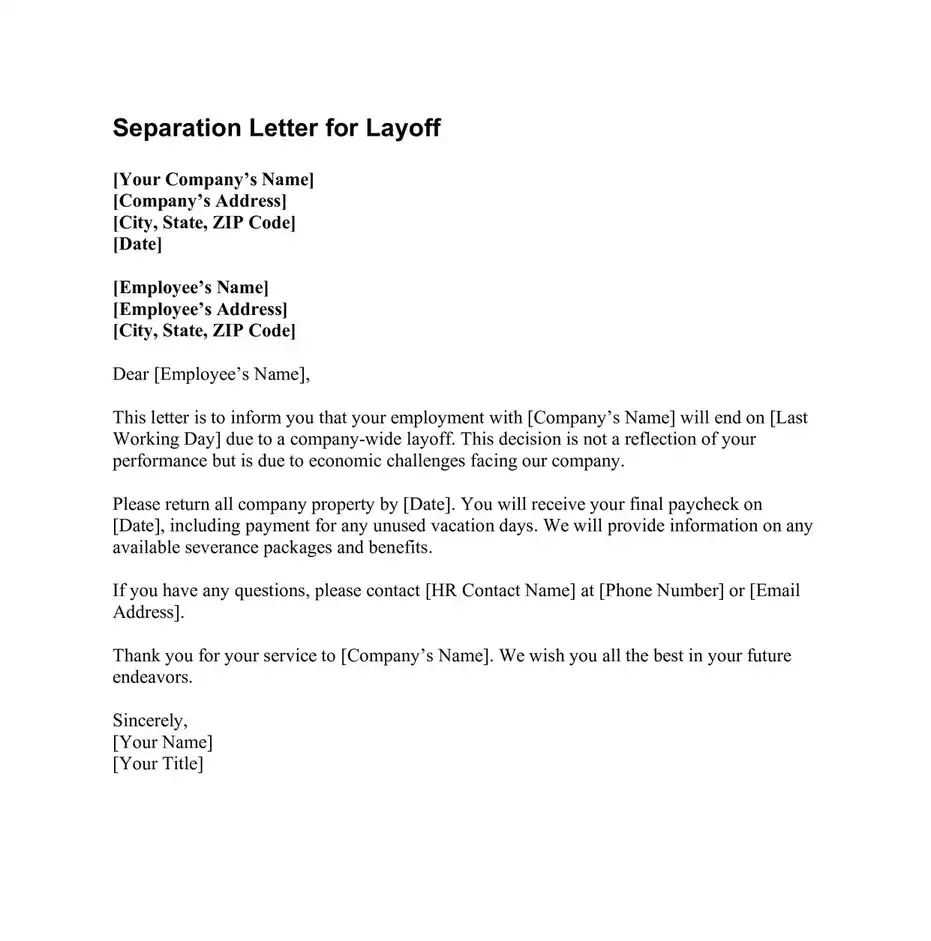
Separation Letter for Contract End
This is a letter confirming the end of employment as per the terms of the employee’s contract. It includes the last working day, thanks to the employee for their work, and details of final pay and returning company property.
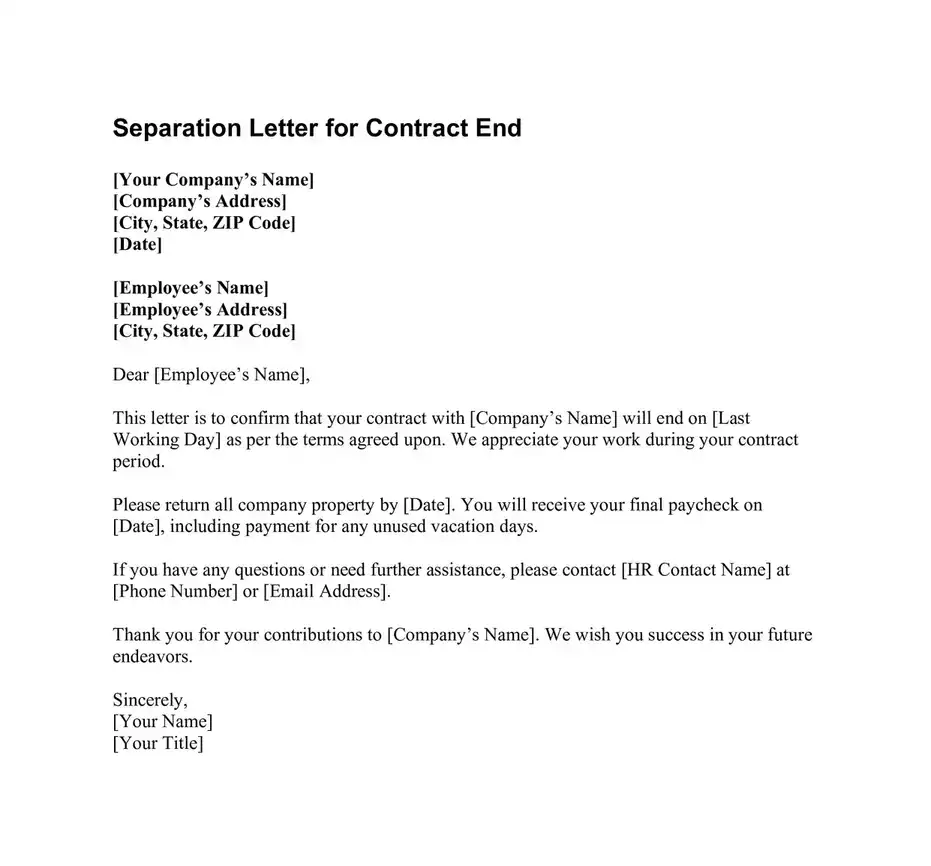
Example Separation Letter
Dear Jane Doe,
This letter informs you that your employment with ABC Company will end on August 31, 2024.
You have been a valued member of the Marketing Department as a Marketing Specialist. Your last working day will be August 31, 2024. The reason for your separation is company restructuring.
Please return all company property, including your ID badge and laptop, by August 30, 2024. You will receive your final paycheck on September 1, 2024. This will include payment for any unused vacation days.
If you have any questions, please contact John Smith at (555) 123-4567 or john.smith@abccompany.com.
Thank you for your contributions to ABC Company. We wish you all the best in your future endeavours.
Sincerely, Mary Johnson, HR Manager
Following these steps, you can write a clear and respectful letter. This helps ensure that the process is smooth and professional for everyone involved.
In conclusion, A separation letter is a vital document in the employment termination process. It provides legal proof, maintains clear records, and can impact future employment opportunities. Employers can ensure that the letter is effective and professional by including all essential elements and following a structured format.
On the other hand, employees should understand their rights and the implications of the separation letter on their careers. Employers and employees can use this simple guide to navigate the complexities of employment termination with greater ease and clarity.

Daniel Wilson Is a Seasoned communications professional and letter-writing expert. With over a decade of experience in corporate and non-profit sectors, Has developed a deep understanding of the power of effective communication.
Specializes in creating versatile letter templates that can be tailored to any situation. In this blog, Daniel shares a passion for the art of letter writing, offering practical tips, customizable templates, and inspiring ideas to help you communicate with clarity, confidence, and impact.








